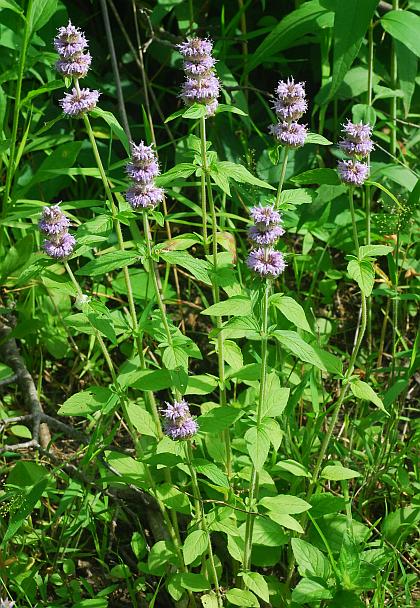Blephilia ciliata (L.) Raf. ex Benth.
Ohio Horse Mint

Native
CC = 6
CW = 5
MOC = 59
© SRTurner
Blephilia ciliata (L.) Raf. ex Benth.Ohio Horse Mint | |
 |
Native CC = 6 CW = 5 MOC = 59 |
© SRTurner |
|
Family - Lamiaceae Habit - Rhizomatous perennial forb with fibrous roots. Stems - Erect, to 60 cm, usually unbranched above base, sometimes stoloniferous, multiple or single from base, 4-angled, densely pubescent, hollow, fragrant.
Leaves - Opposite, decussate, sessile to short-petiolate, fragrant. Petioles to 1.2 cm long, hirsute to villous. Blades to 8 cm long, 5 cm broad, lanceolate to ovate, acute to blunt, ciliate margined, toothed, pubescent on both surfaces, often with longer hairs along main veins on underside.
Inflorescence - Terminal spikes consisting of 1-5 dense, headlike clusters that are noticeably separate along the axis, each with numerous flowers, these sessile or nearly so, subtended by a pair of leaflike bracts and an involucre of conspicuous bractlets, these sessile, ovate, 6-11 mm long, with spreading hairs on the margins. Bracts only slightly exceeding the flowers.
Flowers - Calyces zygomorphic, symmetric at the base, more or less cylindric, the tube to 6 mm, strongly 13-ribbed, glabrous in the mouth, hairy externally, 2-lipped, the lobes shorter than to about as long as the tube, the upper lip 3-lobed, noticeably longer than the 2-lobed lower lip, the lobes narrowly triangular. Corollas zygomorphic, lavender with darker spots, the outer surface pubescent with fine, spreading hairs, the inner surface glabrous, the tube to 1 cm, funnelform, relatively shallowly 2-lipped, the upper lip shallowly 2-lobed, slightly concave to spreading to recurved, the lower lip more or less straight to slightly spreading, 3-lobed. Stamens 2, fused at apex of corolla tube, initially hidden under the upper corolla lip, but becoming exserted at maturity. Filaments to 4.5mm long, glabrous, lilac to purplish. Anthers small, the connective very short and inconspicuous, the pollen sacs 2, appearing more or less sessile and spreading from the filament tip, pink or purplish-tinged to white or pale yellow. Ovary deeply lobed, the style appearing lateral to nearly basal from a deep apical notch. Style exserted, unequally 2-branched at the tip.
Fruits - Dry schizocarps, separating into 4 nutlets, these 0.9-1.2 mm long, oblong-obovoid, the surface reddish brown or black, glabrous, unevenly roughened or pebbled. Flowering - May - August. Habitat - Upland woods, glades, bluffs, roadsides. Origin - Native to U.S. Lookalikes - Blephilia hirsuta. Other info. - This species is found from the U.S. Midwest eastward, and into Canada. It is common in much of Missouri, with the exception of the western third of the state. The Blephilia genus is recognized by the characteristic "stacked" inflorescences appearing like little pagodas. Missouri's two representatives of this genus can be distinguished by a number of attributes. Relative to B. hirsuta, Blephilia ciliata has: a shorter and less branched habit; shorter leaf petioles; flowers which are usually lavender colored rather than white; a preference for drier habitats; and a fragrance which is more like oregano than mint. Both make desirable garden plants, being pleasantly fragrant, striking when in flower, and good for attracting flying insects. Photographs taken in Eminence, MO., 5-23-03 (DETenaglia); also at Razor Hollow Natural Area in Daniel Boone Conservation Area, Warren County, MO, 6-25-2013, and at Shaw Nature Reserve, Franklin County, MO, 5-30-2014 (SRTurner). |